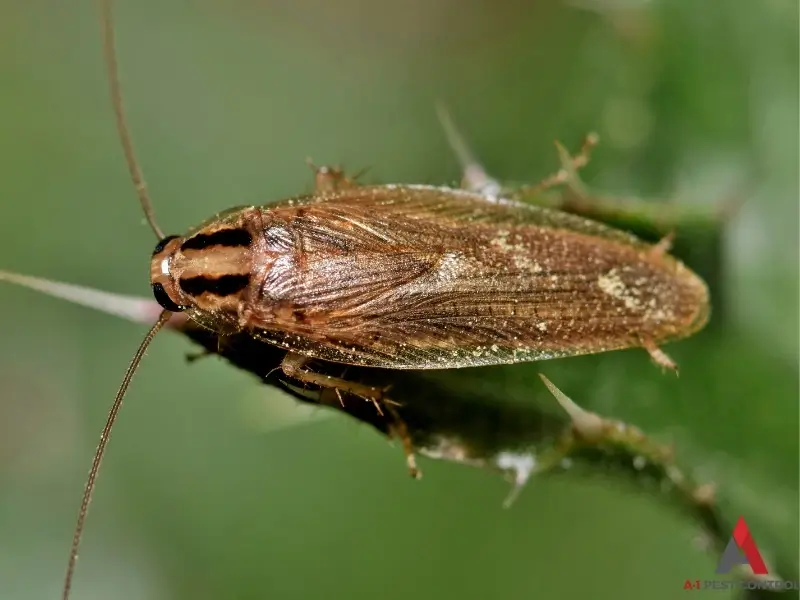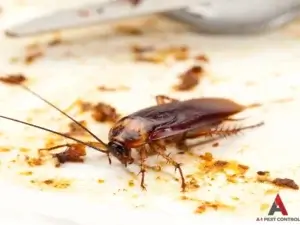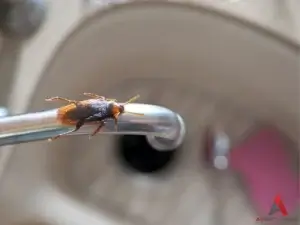
German Cockroach Identification
Contrary to what their name might suggest, German cockroaches are one of the common pests found right here in North Carolina. Known for their adaptability and rapid reproduction, these pests can quickly overrun homes and businesses.
That’s why at A-1 Pest Control, we specialize in eradicating German cockroach infestations and preventing them from cropping up down the line.
Where Do German Cockroaches Come From
German cockroaches are thought to have originated in Southeast Asia, but they have now spread worldwide, becoming particularly common in temperate climates like North Carolina’s.
These cockroaches are excellent hitchhikers, often entering homes through infested grocery bags, boxes, or even appliances. Once inside, they quickly establish themselves, taking advantage of warm, humid environments and any food they might find lying around.
How to Identify German Cockroaches
German cockroaches are small, light brown to tan in color, and typically about ½ to ⅝ inch long. One of their most distinguishing features is the pair of dark, parallel lines running down their back, starting from behind their head.
Unlike larger cockroaches, such as the American cockroach, German cockroaches are more commonly found indoors, particularly in kitchens and bathrooms.

Where are German Cockroaches Most Commonly Found
German cockroaches prefer to stay close to food and moisture, making kitchens and bathrooms their favorite hiding spots.
Behind Refrigerators
German cockroaches are commonly found hiding behind refrigerators for two main reasons: Warmth and food. The back of the fridge creates an ideal hiding spot due to the appliance’s heat, which helps regulate the cockroaches’ body temperature. On top of that, food crumbs or spills near the refrigerator provide easy access to meals without ever having to leave their cozy hiding spots.
Inside Kitchen Cabinets
German cockroaches love to hide inside kitchen cabinets, especially near stored food items. Dark, enclosed spaces provide protection, and if cabinets are not frequently cleaned, they can become ideal breeding grounds.
Cockroaches can easily access food containers, crumbs, or even small leaks in cabinets, which offer them both sustenance and a place to lay eggs. Sealing food properly and cleaning cabinets regularly can help reduce their hiding spots.
Around Sinks and Dishwashers
The moisture around sinks and dishwashers makes these areas particularly attractive to German cockroaches. Leaky pipes, leftover water, and food debris left in the sink create an inviting environment for them. Dishwashers, in particular, often harbor moisture and food remnants that cockroaches can feed on, making them another favorite hiding place.
In Cracks and Crevices of Walls and Appliances
German cockroaches thrive in cracks and crevices of walls, baseboards, electrical outlets, and appliances—tight spaces that they can easily squeeze into. These tight spaces provide them with both shelter and protection from humans and predators.
Keep in mind that German cockroaches are primarily nocturnal, meaning they are most active at night. During the day, they hide in dark, warm, and moist areas, emerging at night to search for food and water. That means you are more likely to see them scurrying around when you turn on the lights in the middle of the night.
What Attracts German Cockroaches
German cockroaches are attracted to warmth, moisture, and food. They are particularly drawn to the following sources.
Food Crumbs and Spills Left on Counters and Floors
German cockroaches are highly attracted to food crumbs and spills left on kitchen counters and floors. Even small traces of food, such as crumbs from snacks or spills of sugary liquids, can be enough to lure them out of hiding. These pests have a keen sense of smell and can quickly detect any accessible food source.
Pet Food and Water Bowls
Pet food and water bowls can act as a continuous food supply for German cockroaches. If left out, particularly overnight, pet food can attract these pests and encourage them to stay close to the area. Cockroaches not only feed on the food but also consume the water, which helps sustain them in dry environments.
Leaky Pipes or Standing Water
Moisture is essential for German cockroaches, and they are often drawn to leaky pipes, faucets, and areas with standing water. Kitchens and bathrooms with plumbing issues, such as dripping faucets or slow leaks under sinks, provide the perfect environment for these pests to thrive. Even standing water that accumulates in places like shower drains or plant trays can be a big problem.
Clutter, Which Provides Hiding Places
Cluttered spaces offer German cockroaches plenty of places to hide and breed. Piles of papers, boxes, or stored items in kitchens, closets, and garages can become ideal hiding spots. Cockroaches prefer to stay in dark, enclosed areas where they feel safe, and clutter provides just that.
While cleanliness is key in reducing the chances of an infestation, even the cleanest homes can attract German cockroaches. These pests are highly adaptable and can survive in environments with minimal food and water sources. They can enter homes through packages, grocery bags, or by hitching a ride in boxes. This is why sealing entry points, maintaining proper sanitation, and working with pest control professionals are important preventive measures, regardless of how clean your home is.
How to Get Rid of German Cockroaches
Getting rid of German cockroaches requires a comprehensive approach. A-1 Pest Control offers customized solutions that may include:
- Bait stations and gel baits: These attract the cockroaches and allow them to bring poison back to their colony.
- Insect growth regulators (IGRs): These chemicals prevent cockroaches from reaching adulthood and reproducing.
- Crack and crevice treatments: We apply targeted treatments in areas where cockroaches hide.
- Sanitation and exclusion: We advise reducing food sources and sealing entry points to prevent further infestations.
German Cockroach FAQ
Does seeing a German cockroach indicate an infestation?
Yes, seeing even one German cockroach often indicates an infestation. These cockroaches reproduce rapidly, and if you spot one, there are likely many more hiding nearby.
What to do if you find a German cockroach?
If you spot a German cockroach, it’s essential to act quickly. Clean up any food sources, reduce clutter, and contact A-1 Pest Control to assess and eliminate the infestation.
Is it normal to have roaches in North Carolina?
Roaches are a common problem in North Carolina due to the warm and humid climate, which provides an ideal environment for them to thrive. However, with proper prevention and pest control measures, you can keep your home roach-free.
Why do I suddenly have German roaches?
German roaches can enter your home through infested items or by moving from neighboring apartments or businesses. A sudden appearance could mean they’ve found a new food or water source inside your home.
Do German cockroaches carry diseases?
Yes, German cockroaches can carry diseases. They are known to transmit various harmful bacteria and pathogens, such as Salmonella, E. coli, and Streptococcus, which can cause food poisoning, dysentery, and other illnesses. Their feces, shed skins, and saliva can also trigger asthma and allergies, especially in sensitive individuals. Cockroaches spread these pathogens through contamination of surfaces and food, making them a serious health hazard. Regular pest control and sanitation are crucial to minimize these risks.
Contact A-1 Pest Control for German Cockroach Control
If you’re dealing with a German cockroach infestation, don’t wait—contact A-1 Pest Control today. We provide effective pest control plans in Blowing Rock, Hendersonville, Hickory, Lenoir, Mooresville, and West Jefferson, North Carolina. Let our experts handle the problem so you can enjoy a pest-free environment. Call us at 828-481-9140 or fill out the form below for a FREE inspection.


